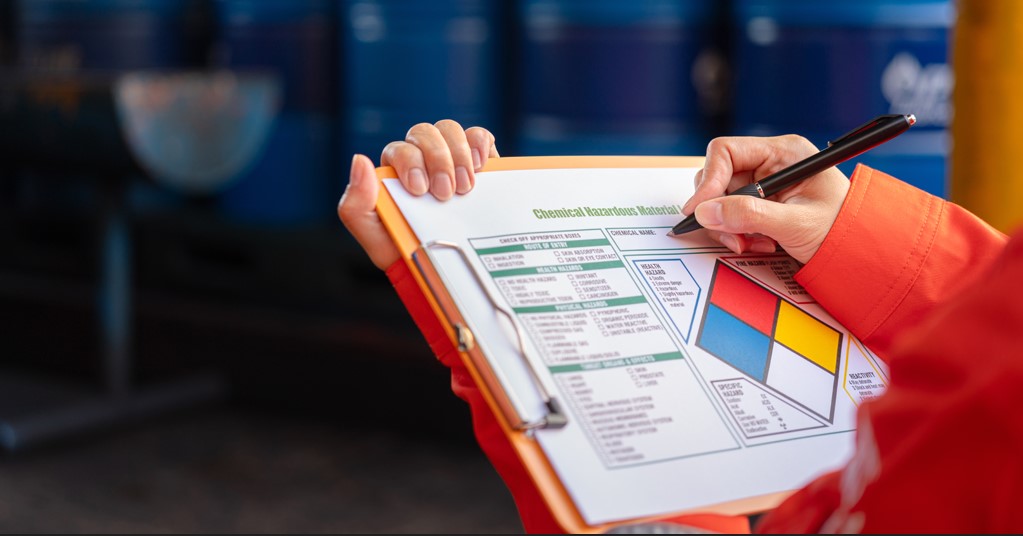
New SDS-Based Chemical Sign Selector at ComplianceSigns.com

Now It’s Easy to Find the Signs You Need for the Chemicals You Use
Chemicals commonly found in many workplaces require a variety of signs or labels to identify their potential hazards. But clearly defining which signs to use for each chemical has always been a challenge. Now there’s an easy-to-use tool to help identify correct signs for common chemicals: The Chemical Sign Selector at ComplianceSigns.com.
This new tool uses hazard information from actual safety data sheets to show a unique Chemical Safety Collection of relevant signs for each chemical. Simply enter a chemical name, CAS number or UN number to view appropriate signs in seconds, as well as a free SDS for each chemical.
Depending on their operation, companies may need signs addressing hazards and health risks, required PPE, handling procedures or transportation instructions required by regulatory bodies including OSHA, NFPA, DOT or DOD. ComplianceSigns analyzed Safety Data Sheets for the most common industrial chemicals to identify appropriate hazard warnings, signs and labels. The result is a unique collection of signs for each chemical, which can include:
- NFPA hazard diamonds
- GHS labels
- Hazmat warnings
- PPE notices
- DOT placards
- Pipe markers
- Emergency information
- Other warnings indicated on the SDS
Selector users will have to decide which specific signs, labels or placards they need for their unique operations, but the Chemical Sign Selector quickly shows a collection of safety signs related to the given chemicals.
Developing the Chemical Sign Selector
“The idea of a tool to help people select correct chemical signs grew from our customers,” said ComplianceSigns President Paul Sandefer. “Our customer service team frequently receives calls from people asking for help selecting signs related to specific chemicals. They needed an easy way to identify PPE and other safety precautions for the chemicals they use,” Sandefer said. That sparked a plan to build a tool that would help customers find what they need from the company’s extensive chemical safety offering.
“Safety Data Sheets are the best source for details on safe chemical use, so we started there,” Sandefer explained. The company identified the most common industrial chemicals and partnered with MSDSonline.com to access Safety Data Sheets for those chemicals. A development team reviewed the SDSs to identify correct HazCom messages and requirements for each chemical. They then matched them to correct signs and labels in the company’s extensive sign library. Next the company website team used the data to create the selector tool, with the challenging goal of making it both comprehensive and easy to use. The result is a tool that lets users select chemicals by CAS#, UN#, or by entering or selecting a chemical name. The company also created a how-to-use video for the selector.
This isn’t the first time ComplianceSigns has created a unique tool to address customer needs. The company has developed a variety of custom sign generators, as well as a tool for California Proposition 65 warning notices.
“It’s worth the extra effort to help our customers and truly meet their needs,” said Sandefer. “We understand that safety regulations are complicated, and that small businesses often don’t have the time or resources to do a lot of research. So we provide resources that can make their jobs a little easier.” Those materials include Compliance Resource Bulletins on GHS, NFPA 704, Hazchem, pipe marking, hazmat and many other topics, as well as a workplace safety blog with a variety of news, tips and articles.
Chemical Safety in the Workplace
The Bureau of Labor Statistics reports that hundreds of private industry workers die from exposure to harmful substances or environments every year, including chemicals and other biohazards. In 2017, these hazards contributed to 37,110 nonfatal injuries/illnesses involving days away form work.
Many workers are unaware of chemicals that create potential hazards in their work environment. This makes them more vulnerable to exposure and injury. To ensure chemical safety in the workplace, information about the identities and hazards of the chemicals must be available and understandable to workers. The Occupational Health and Safety Administration (OSHA) defines a hazardous chemical as any chemical which can cause a physical or health hazard, and requires employers to communicate these hazards to workers.
OSHA’s Hazard Communication Standard (HCS) dictates that information about chemical and toxic substance hazards in the workplace and associated protective measures must be shared with workers. All employers with hazardous chemicals in their workplaces must have labels and safety data sheets for exposed workers, and train them to handle the chemicals appropriately. Training for employees must also include information on the hazards of chemicals in their work areas and measures to protect themselves.
Employers must comply with a number of standards where employees are potentially exposed to chemical hazards. OSHA standards that generally apply to hazardous substances include the Hazard Communication standard (1910.1200) and the Respiratory Protection standard (1910.134). Employers may also need to provide personal protective clothing where there is a potential hazard from skin contact with chemicals, or eye and face protection to guard against chemical splashes.

